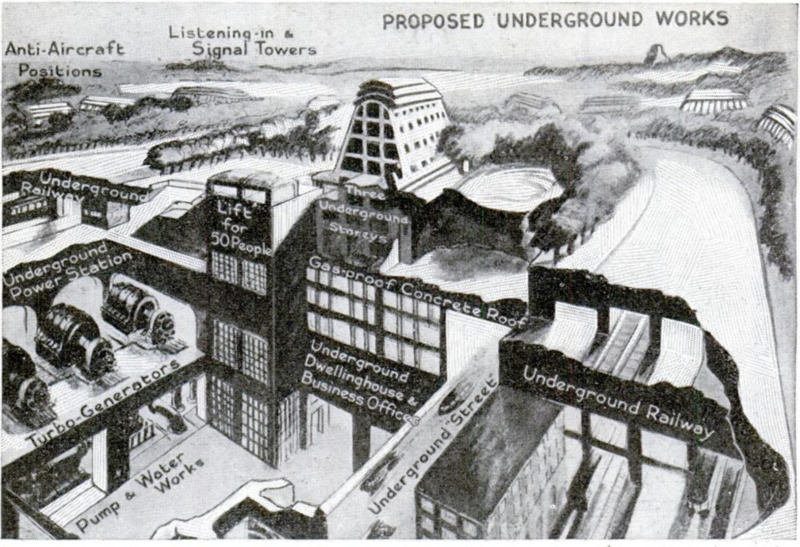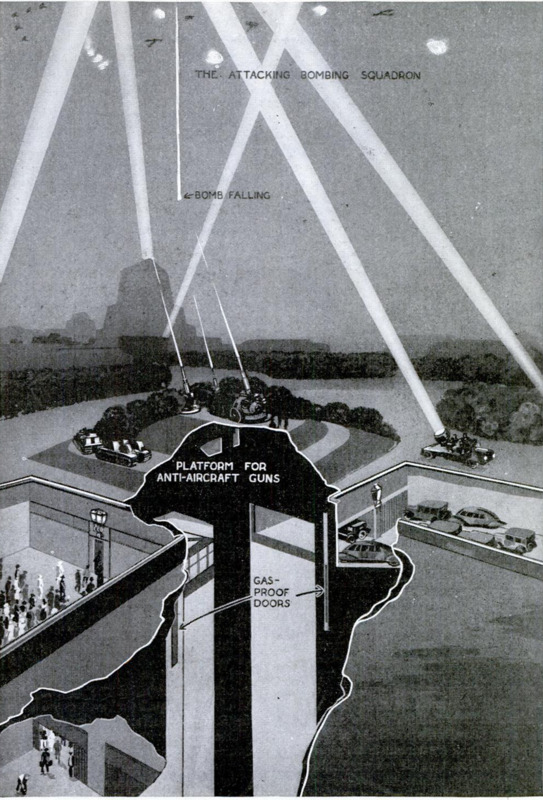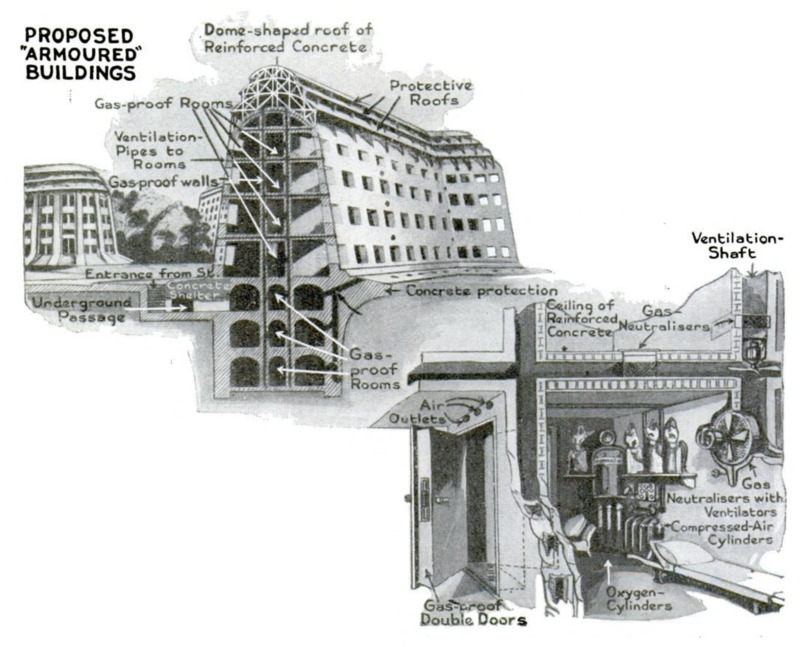-
Titolo
-
Bomb and Gas-Proof Cities of Future
-
Article Title and/or Image Caption
-
Bomb and Gas-Proof Cities of Future. Russians Plan Weird Architecture to Save Civilian Population against Possible Attack by Fleets of Giant Air Raiders
-
extracted text
-
MEN may have to go back to their cave-dwelling ancestors and live a large part of their lives underground; big cities may have to be decentralized and spread, in low-lying buildings, over vast areas, broken up by parks and open spaces, if the threatened horrors of aerial warfare really materialize.
Those are the conclusions reached by soviet officials in Moscow, who are busy at work planning a gas and bomb-proof city capable of resisting attack from the air. The soviet architects featured a recent anti-war "Scare Week" with plans for such a city. The plans called for vast subterranean cities, covered by reinforced-concrete roofs, which in turn were buried under many feet of sod and earth. Railways and streets, as well as sidewalks, would also be placed underground. Such buildings as would be permitted above ground would be limited to four stories in height. The outer walls would taper, to offer the smallest possible target from above, and they would be surmounted by triple reinforced-concrete roofs, with honeycomb air spaces between to take up the shock of an exploding bomb. The roof idea is similar to the blister plan used as a submarine defense for warships, an outer shell or blister exploding the torpedo on contact, and the inner space taking up the shock before the main hull is reached. Not all bombs explode on contact, but the triple roofs would offer sufficient resistance to stop even a penetration type and explode it before the interior of the building could be reached.
Every outlet to the air, including all doors and windows, would be rendered gas-proof, while the underground passages and refuge rooms would be protected against poison gas by double doors, elaborate ventilating systems and powerful exhaust fans which could sweep a strong current of air across all openings to form an invisible barrier that would brush gas fumes away.
Above ground, the occasional four-story building would be set in the midst of wide-spreading parks, which would cover the labyrinth of cave dwellings deep beneath the surface. Occasional listening and signal towers and platforms for anti-air-craft guns would be interspersed among the scattered houses.
Another idea advanced by the Russians is the building of powerful gas neutralizers, which would draw the gas-laden air through water spray and chemicals and release it as pure air again.
The possibility of horrors in the next war beyond anything hitherto dreamed of is being given consideration throughout Europe, especially in Russia, Germany and England. A German magazine, Die Woche, recently pointed out that in the next war a city such as New York, with its tremendously tall buildings and enormous concentration of millions of defenseless people in a restricted area, would be "a giant with feet of clay, a veritable man trap." Bombing planes, the writer pointed out, have risen two miles into the air carrying a load of six and a half tons of bombs, besides the weight of the crew and their supplies. Modern bombers can carry spread a curtain of death over a vast area. A 225 to 525-pound bomb would demolish a big building, and the larger sizes, weighing from 1,640 to 3,280 pounds, as used in bombing tests, would each wipe out an entire city block.
Lord Halsbury, former assistant inspector of high explosives in the British ministry of munitions, writing in the London Daily Mail, recently said:
"In a war of any magnitude there will not merely be armies engaging armies, but whole nations mobilized against nations. It inevitably follows that the old demarcation between the military forces and civilian population will cease to exist. The first conclusion that emerges is that an attack will be made upon the civilian population. From the dislike of facing unpleasant truths, an answer comes readily to many.
'London,' it is said, 'was bombed during the war, and not much damage was done after all.' The answer omits one very serious consideration. London was attacked with incendiary and explosive bombs. Since then great strides have been made in chemical war-fare. The only other answer that may be made is that it would be impossible to drop sufficient gas. Some two years ago, I pointed out that, in the vital triangle including the Thames docks and Clapham junction, 2.000 tons of gas would create a lethal atmosphere over all that area to a height of forty feet."
-
Lingua
-
eng
-
Data di rilascio
-
1927-12
-
pagine
-
924-927
-
Diritti
-
Public Domain (Google digitized)
-
Archived by
-
Alberto Bordignon





